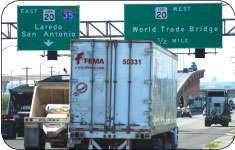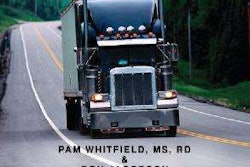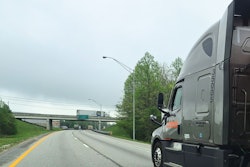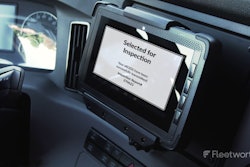
Electronic Logging Devices
The bill requires DOT to establish regulations mandating electronic logging devices (EOBRs) for motor carriers currently required to complete paper logs. The regulations must be in place within 1 year; carriers will have two years thereafter to adopt/install the devices.
34 Hour Restart Study
The bill requires DOT to complete a field study – by March 31, 2013 – of the efficacy of the changes to the hours of service 34 hour restart provision, due to go into effect in July 2013. The language does not prohibit the agency from putting the restart changes into effect based on (or pending) the results of the study.
Broker Bond
Increases the broker bond to $75,000 and applies it to freight forwarders. It also tightens requirements on bonding companies to respond to carrier claims and includes amending language allowing authorized motor carriers the flexibility to subhaul during the busiest times of the year.
Drug and Alcohol Clearinghouse
The bill requires DOT to establish – within 2 years – a clearinghouse to capture drivers’ positive drug/alcohol test results and records of refusals to test. Motor carriers will be required to query the clearinghouse when screening new driver applicants and annually thereafter. Third party service agents will be permitted to conduct these inquiries on behalf of motor carriers.

Employer Notification Systems
Within one year, FMCSA must establish standards for state systems that automatically notify motor carriers of drivers’ moving violations and other driver record changes (e.g., suspensions). Motor carriers may use these systems to meet the current annual motor vehicle record review requirements. Within 2 years, FMCSA must develop recommendations and a plan for implementing a national system to perform these functions.
New Entrant Testing and Audits
DOT must require motor carriers entering the industry (new entrants) to complete a proficiency test on the safety regulations and to complete a DOT safety review within 12 months (the current deadline is 18 months).
Truck Parking
Investment in truck parking is eligible, but the bill eliminates a pilot program which set money aside for truck parking projects. The bill requires a study to determine the extent and location of truck parking shortages. [Subtitle D, Section 1401, is titled Jason’s Law — in reference to U.S. trucker Jason Rivenburg, slain while parked in the lot of an abandoned business in South Carolina in lieu of a better option. The fact that this was included in the language of the bill is a testament to the long work of truck drivers; for background on the long story check out this link for our past coverage.]
Truck Size and Weight
No increase in size and weight limits, other than an increase in allowable weight for idling reduction devices from 400 pounds to 550 pounds. The bill requires USDOT to conduct a comprehensive size and weight study that is due in two years. However, it is unlikely the study will be completed in this timeframe.
Allows states to issue 120 day oversize-overweight permits to trucks responding to disasters if a national emergency is declared.
Tolls
The bill effectively maintains the status quo on allowing states to toll existing Interstates, but makes it easier to build new Interstate lanes with toll financing.
Public-Private Partnerships
The Senate bill language which would have curtailed PPPs was not included.
USDOT is to compile best practices to ensure that public and state and local government interests are protected in the course of negotiating a PPP. USDOT is to develop model PPP contracts.
Crashworthiness Standards
The bill includes language directing DOT to study the need for crashworthiness standards for large trucks, including an evaluation of the need for roof strength, pillar strength, air bags, and other occupant protection standards, as well as frontal and back wall standards.
Hazmat
DOT is proscribed from publishing a wetlines rule for two years or until a GAO study determines whether such a rule will be necessary.
PHMSA is to update its accident and release recordkeeping and reporting requirements and direction for DOT to set mandatory standardized training for HM enforcement.
DOT is to set mandatory, standardized training for hazmat enforcement officials and require PHMSA to update its hazmat accident and release information collection, analysis, reporting, and data use methods.
The bill failed to include provisions from the House bill that would have fixed a previous legislative error that extended OSHA’s jurisdiction into areas already regulated by DOT, a prohibition on State hazmat incident reporting requirements that differ from PHMSA’s, and a provision requiring the States to participate in the Hazmat Uniform Carrier Permit Program.
Transportation of Agricultural Commodities and Farm Supplies
Clarifies movement of farm supplies, under the agriculture exemption to the hours of service rule, from a terminal or distribution point to the retail site or farm.
The language also increases air mileage from 100 to 150 and eliminates “in the state” from the language, making it an interstate issue.
Pension Funding Stabilization
Single employer pension programs — stabilizes interest rates that are used to calculate employee contributions. Interest rates are averaged over a 25 year period. Employers pay less into the employees’ pension plan (calculating for higher interest return) and use that savings on investing back into the business. The investments back into the business are then taxed and the government receives additional tax revenue.
Eligibility for Non-Highway Projects
The bill does not expand eligibility to additional non-highway projects. It eliminates eligibility for landscaping and other scenic beautification; historic facilities; and transportation museums.
Minimum State Apportionment
The minimum share of highway funding for each state is increased from 92% to 95% of the total.
Performance Standards
Each state and metropolitan area is required to establish minimum performance standards related to highway and bridge maintenance, congestion and system reliability, safety, freight efficiency, air quality and project delivery. If states fail to meet these standards they will be required to transfer federal funds from other areas in order to meet the standards.
Freight Policy
The bill establishes a new National Freight Network and requires USDOT to create a national freight plan.
The freight plan is to include an assessment of the condition and performance of the national freight network and identification of highway freight bottlenecks.
The federal share for highway projects that significantly improve freight efficiency is increased from 80% to 90% for projects off the Interstate System and 95% for projects on the Interstate System.
The bill does not include a set aside of funding for freight projects included in the Senate bill.
Accelerated Project Delivery
Significant reforms to planning and environmental requirements for projects built with federal-aid money. This will reduce project costs and speed up construction.
Projects of National and Regional Significance
$500 million from the General Fund for a USDOT grant program for major projects. Eligibility for highway, transit, rail and other modes.













